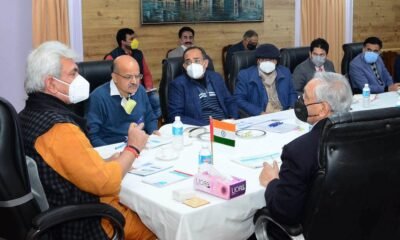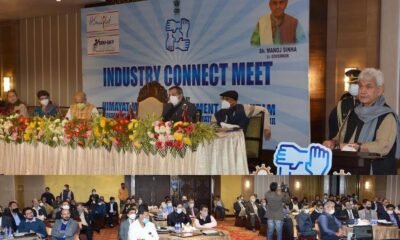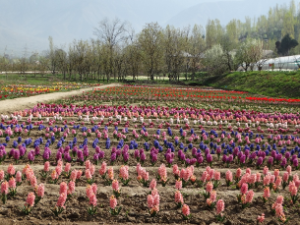Dr Binish Qadri
Malik Daniyal Shabir
The choices consumers make today are no longer limited to price and utility. Increasingly, purchasing decisions are being shaped by deeper concerns—about the environment, labour ethics, health, and long-term sustainability. This shift in consumer consciousness has brought ethical consumerism to the forefront of economic and social discussions. Ethical consumerism, at its core, is a form of activism. It transforms everyday market behaviour into a statement of values, where individuals engage with the marketplace not just as buyers, but as participants in shaping a more equitable and sustainable world.
One area where the impact of ethical consumerism is especially visible is the organic market. Organic food is not just about pesticide-free vegetables or hormone-free milk; it represents a broader commitment to a way of life that values nature, fairness, and health. The rise of the organic market is not merely a trend, but a response to a collective moral impulse—one that sees food as a gateway to better living for individuals and communities alike.
Ethical consumerism is not an entirely new phenomenon. It can be traced back to movements like boycotts of slave-produced sugar in the 18th century and, later, fair-trade campaigns in the 20th century. As globalisation expanded markets, it also exposed consumers to the darker side of production—sweatshops, deforestation, animal cruelty, and chemical abuse. Simultaneously, the organic farming movement took root, driven by concerns over synthetic fertilisers, pesticides, and declining soil health. What began as a fringe movement soon gained traction with the rise of environmental activism and public health awareness. In India, government recognition and consumer interest have boosted organic farming policies and local organic brands. Together, these developments forged a shared moral and ecological ground between ethical consumerism and the organic movement.
Organic food is not just about pesticide-free vegetables or hormone-free milk; it represents a broader commitment to a way of life that values nature, fairness, and health. The rise of the organic market is not merely a trend, but a response to a collective moral impulse—one that sees food as a gateway to better living for individuals and communities alike.
Health has long been a personal concern, but in recent years it has also taken on moral dimensions. The link between food choices and long-term well-being is clearer than ever, and consumers are beginning to view the act of buying food as an ethical choice. Rising rates of lifestyle diseases, antibiotic resistance, and food adulteration have forced many to question conventional agricultural systems. Organic food offers an alternative that aligns with both personal and societal health goals. Choosing food grown without harmful chemicals becomes not just a self-protective act but a gesture of solidarity toward a cleaner environment and a healthier community. In this light, the push for organic food becomes not merely a dietary decision but a reflection of a broader ethical framework.
There is a complementarity between ethical consumerism and the organic market. Both affect and get affected by each other. The consumption of organic food has moral considerations, such as health and social concerns including the environment and sustainability. Agricultural economics is witnessing a rising trend and craze for organic food, which is visible in the shift in the consumer taste and demand towards organic food. The mounting health issues among general population, especially among young folks are pressing hard for development of the organic market. Consumers are the king of the market who increasingly see organic food as a way to support eco-friendly or sustainable farming practices, safeguard the environment, and avoid chemicals linked to traditional farming.
As far as ethical consumers are concerned, they are often inspired by concerns about environmental impact, human rights, human freedom, and animal welfare, which coincides with the organic farming canons. In other words, they are bothered about the holistic socio-environmental and animal welfare outcomes of their purchasing power decisions. They give importance to the goods that are in accordance with their ethics and moral values, including environmental sustainability and objective labour activities. This contains refraining from goods from firms with a bad reputation or buying from firms displaying moral conduct right from scratch. They pay a pivotal role in promoting sustainable development, meeting needs of the present generation without compromising the needs of the future generations. They provide backup to ethical trade and commerce. They give top priority to companies with a great ethical background and sustainability principles, giving a clear-cut message that moral values are above all. Moreover, they stimulate demand for sustainable goods. They prefer fair-trade goods, organic food, and sustainable goods, and accordingly, create a demand for sustainable substitutes, promoting innovations (especially green innovation) and produce sustainable and green goods. The moment they do away with those companies that promote unethical and unsustainable practices, they basically drive a long path towards sustainable development. It has a dual effect: On one hand, it restricts child labour and immoral labour practices and on the another hand, it reduces environmental degradation. Furthermore, ethical consumers can promote environmental responsibility by raising awareness about social and environmental issues. They always prefer well-informed choices, thereby empowering consumers in every possible manner. By making informed choices, they be held personally responsible for their actions impact on the social systems and environment.
In states like Sikkim, which declared itself fully organic in 2016, consumer support and political will came together to build an ecosystem that values soil health, farmer welfare, and chemical-free produce. Farmer cooperatives and weekend organic markets in cities like Bengaluru, Pune, and Delhi have become popular precisely because they appeal to a consumer base that wants its spending to reflect its values. These cases show that ethical consumption is more than a concept—it is a living force with the power to transform how food is grown and consumed.
Across the globe and within India, the convergence of ethical values and organic preferences is reshaping markets. Brands like Organic India and 24 Mantra Organic owe much of their success to ethically conscious consumers who demand transparency, sustainability, and purity. In states like Sikkim, which declared itself fully organic in 2016, consumer support and political will came together to build an ecosystem that values soil health, farmer welfare, and chemical-free produce. Farmer cooperatives and weekend organic markets in cities like Bengaluru, Pune, and Delhi have become popular precisely because they appeal to a consumer base that wants its spending to reflect its values. In states like Sikkim, which declared itself fully organic in 2016, consumer support and political will came together to build an ecosystem that values soil health, farmer welfare, and chemical-free produce. Farmer cooperatives and weekend organic markets in cities like Bengaluru, Pune, and Delhi have become popular precisely because they appeal to a consumer base that wants its spending to reflect its values. These cases show that ethical consumption is more than a concept—it is a living force with the power to transform how food is grown and consumed.
While the growth of ethical consumerism and the organic market is promising, it is not without obstacles. One major challenge is greenwashing—where companies falsely advertise their products as ethical or organic, misleading well-meaning consumers. There is also a cost barrier: organic and ethically produced goods are often more expensive, making them inaccessible to a large section of the population. Certification standards vary, and not all organic products undergo rigorous verification, creating confusion and mistrust. Moreover, the effectiveness of ethical consumerism hinges on access to information. In many regions, consumers lack the knowledge or tools to make informed choices, limiting the reach of these movements. These challenges must be addressed to sustain momentum and ensure that ethical consumerism remains a genuine force for good.
The relationship between ethical consumerism and the organic market is not incidental—it is deeply rooted in shared values and mutual influence. Ethical consumers drive demand for organic products, while the organic market offers them a platform to express their values through everyday choices. Together, they form a powerful nexus capable of reshaping economies, societies, and ecosystems. To deepen this impact, there is a need for stronger regulations, better consumer education, and more inclusive pricing strategies. Only then can this movement become not just the preference of a few but a sustainable norm for the many.
Dr Binish Qadri is former Assistant professor, Cluster University Srinagar and Malik Daniyal Shabir is an undergraduate student at the University of Delhi. They can be reached at qadribinish@gmail.com



 Industry5 years ago
Industry5 years ago


 Economy3 years ago
Economy3 years ago


 Energy5 years ago
Energy5 years ago


 Infra5 years ago
Infra5 years ago


 AgriBiz5 years ago
AgriBiz5 years ago


 Review5 years ago
Review5 years ago


 Jobs5 years ago
Jobs5 years ago


 Careers5 years ago
Careers5 years ago
















